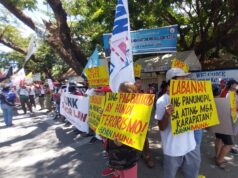Originally staged in 1880, or 137 years ago, this theatrical- ritual, which is sustained by faith and spiritual vows, it has been listed by the National Commission on Culture and the Arts as a “National Intangible Cultural Heritage”.
The staging of the play is the main feature of the village’s “Pista ng Mahal na Sta. Cruz” in the first week-end of May, on the 6th and 7th this year.
The play celebrates the finding of the cross on which Christ was believed to have been crucified. Titled “Flores de Mayo,” it revolves on the conflict of two warring groups – the Christians in the Medieval European kingdom and the Muslims in the Middle Eastern fiefdom.
The script, with 183 pages containing 10 sub-titles, has 16 major personajes (characters), nine on the Christian and seven on the on the Muslim sides with some others in minor roles. On the Christian side are Queen Helena, her handmaids, King Constantine, a general of the army, two dukes, a prince, and a brave warrior. On the other side are the emperor, Princess Erlisa, an army general and three outstanding officers.
The role players wear colorful costumes which are almost of similar design. The Christians distinguished by a banda (sash), the Muslims by a feathered headdress.
The gist of the story, culled from the documentation of Prof. Florante Ibarra of the Central Luzon State University (CLSU), is as follows:
“Queen Helena of the Roman Empire confers with her generals about the plan to crown Prince Constantine as the new king of Rome. Before the coronation, Muslim troupe tried to obstruct the coronation by bringing war to the Roman Empire but was repulsed. When Constantine sits on the throne, the emperor of Turkey, through his ambassador, asks Constantine to surrender his crown and scepter otherwise the Muslim warriors shall kill all Christians in Rome. Constantine refuses and declares war with the emperor.
“An angel appears to Constantine and orders him to go to Jerusalem and search for the Holy Cross on which Christ was crucified and died.
“On their way, Constantine and his men smell a delicate scent of fragrance from the ground. Digging, they found three crosses. To identify which of those is the Holy Cross, Queen Helena puts the crosses one by one on the chest of a sick woman. The last cross cures the woman.
“On their way back, the cross was taken by a king’s group and demanded for the life of King Constantine. Bloodbath takes place. The Christians won the fight and captured the king and his soldiers, the emperor of Turkey steps down from the throne and surrenders his crown to Constantine.”
One sub-plot says the daughter of the king surrendered to a Christian soldier with whom she is secretly in love.
“The Araquio is a form of entertainment and devotional expression sustained by panatas (vows). It also includes the participation of devotees in the pantot (dance ritual),” Ibarra said.
The research and documentation by Ibarra was in connection with his dissertation titled “Transmission of Araquio Music, Songs, and Movement Conventions: Learning, Experiences and Meaning in Devotional Theatre”. He presented it in 2012 for the completion of his Doctor of Education in Music course at the Teachers College of Columbia University, USA.
Maestros (araquio teachers) train the characters and direct the play. A musical band, a mantinidor (announcer), and an otor (prompter) are essential; to the play. This year, Feliciano Peralta, 41; Rodrigo Peralta, 67; and Florentino Peralta, 53, act as maestros. The hermana mayor is Nanang Jessie with 11 other sponsors.
The sub-titles of the script are “Mahal Na Sta. Cruz”, “Mahencio”, “Torneo”, “Saladrino”, “Paghanap Sa Cruz”, “Costruwas”, “Pagsinta Sa Cruz”, “Panalangin sa Prusisyon”, “Ang Sampung Utos ng Diyos”, and “Pagsasalin”.
On the first day of the presentation, the play climaxes in the evening with the search and finding of the cross on 12 backyards in the village each with simulated mountains. Expectedly, three crosses are found but how the Christ’s cross is authenticated caps the night’s scenes.
In the last part of the play (Sunday night), the veneration of the cross, the ritual dance and the passing of the cultural torch to the sponsors are held.
“The devotees, including members of the band, dance for more than an hour. Money bills are given as gift to the participants,” Ibarra observed.
Players recites their lines in decho, an stylized delivery with unique intonation with hand gestures, he said. The movements on the staged for formations are estrado, (u-shape), ehersito (semi-circle), rebista (diagonal),panagaan (forward- backward), and paradang pa-krus (cross-shaped).
Some of the songs are Dalagang Pilipina , O Maliwanag na Buwan, Lawiswis Kawayan, Hanging palay-palay, Ang Puso ko’y Nagkamit, Paru-paro, Sa Libis ng Nayon, Awit sa Hardin, Tangi, and Pamimitas ng Bulaklak.




